Cow Reticulated Python
Malayopython reticulatus
Cow reticulated pythons hatch solid white, then develop spots as they mature.
Advertisement
Cow Reticulated Python Scientific Classification
- Kingdom
- Animalia
- Phylum
- Chordata
- Class
- Reptilia
- Order
- Squamata
- Family
- Pythonidae
- Genus
- Malayopython
- Scientific Name
- Malayopython reticulatus
Read our Complete Guide to Classification of Animals.
Cow Reticulated Python Conservation Status
Cow Reticulated Python Facts
- Prey
- Small rodents, birds, rabbits, and anything it can overpower.
- Main Prey
- Mammals and birds
- Name Of Young
- Hatchlings
- Group Behavior
- Solitary except during mating season
- Fun Fact
- Cow reticulated pythons hatch solid white, then develop spots as they mature.
- Estimated Population Size
- Unknown, captive bred
- Most Distinctive Feature
- Spots that develop with age.
- Litter Size
- 15-80
- Lifestyle
- Nocturnal
- Diurnal
- Common Name
- Cow retic
- Origin
- Specially-bred morph
Cow Reticulated Python Physical Characteristics
View all of the Cow Reticulated Python images!
“When cow reticulated pythons hatch, they look just like any blue-eyed lucy.”
The beautiful cow reticulated reticulated python is specially bred for its color. Captive bred reticulated pythons make terrific pets for giant snake lovers because they are as attractive as they are friendly and intelligent. This color morph is the result of two different color genes interacting in a way that creates an ever-increasing number of spots throughout the snake’s life.
Incredible Cow Reticulated Python Facts
- Reticulated pythons are huge snakes that sometimes exceed 25 feet in captivity.
- Also called retics, reticulated pythons are one of the most popular giant pet snakes with many different color and pattern combinations.
- Cow-reticulated pythons are a specialized color morph that starts white and gradually develop spots as they age.
Where to Find Cow Reticulated Pythons
Wild reticulated pythons live in dense jungles and forests near water sources in south and southeast Asia. They are native to countries like Brunei, Bangladesh, and Cambodia. However, you won’t find a cow reticulated python in the wild. It’s a specialized color morph bred for the pet trade.
Cow Reticulated Python Scientific Name and Classification
Although the cow reticulated python looks significantly different than a wild snake, it’s part of the same species. These Pythonidae family members are cousins to green tree pythons, Boelen’s pythons, and Burmese pythons.
Their scientific name is Malayopython reticulatus. Genetically speaking, Malayopython is a sister genus to the Python genus, even though they used to be included in that genus. It’s basically a way to classify them separately but honor the close genetic relationship between them. The specific name, reticulatus, means net-like — it’s a Latin word that refers to their color pattern.
Types of Reticulated Python Morphs
Reticulated pythons have over 30 genetic traits that breeders combine in different snakes to achieve various morphs. Similar to the hundreds of ball python traits, reticulated python breeders work to create new and beautiful combinations for the pet trade. Some traits, like pied and albino, occur in nature, but others need selective breeding to achieve. Here are a few:
- Pied reticulated python
- Orange stripe reticulated python
- Pewter
- Phantom
Cow Reticulated Python Appearance and Description
Reticulated pythons are giant snakes — the longest in the world. They grow over 20 feet long with regularity in captivity but rarely exceed that in the wild. If some of the rumors are true, a few snakes may have been over thirty feet. These snakes prefer mammals and other warm-blooded prey like birds and in the wild, will eat nearly anything they can overpower.
There are a few confirmed deaths caused by a reticulated python, but humans aren’t generally on their menu. Our shoulders usually make it impossible for them to swallow a healthy adult. However, smaller people like children and the elderly have fallen prey on a few occasions.
About the Cow Reticulated Python Morph
When a reticulated python carrying the incomplete dominant phantom gene breeds with one carrying the recessive orange ghost stripe, there’s a chance you’ll find a few cow retics in the clutch. Both traits originally came out of New England Reptile Distributors’ breeding program.
The reduced phantom pattern and the orange ghost stripe’s brilliant oranges combine in a wonderful way, creating the cow-reticulated python morph. When this reticulated python morph hatches, it’s solid white with maybe a spot or two and has blue eyes. Unless you knew the neonate was a cow-reticulated python, you’d probably think it was a blue-eyed leucistic (also known as BEL or blue-eyed Lucy).
After shedding a few times and as it ages, the snake starts developing black, yellow, and sometimes green spots. However, black is the predominant color. Eventually, a cow reticulated python ends up with as much black on the top as there is white on the bottom — making them look like the reptile world’s answer to a Jersey cow. These spots develop because of the interaction between the phantom gene and the orange ghost stripe.
Pictures and Videos of Cow Reticulated Pythons
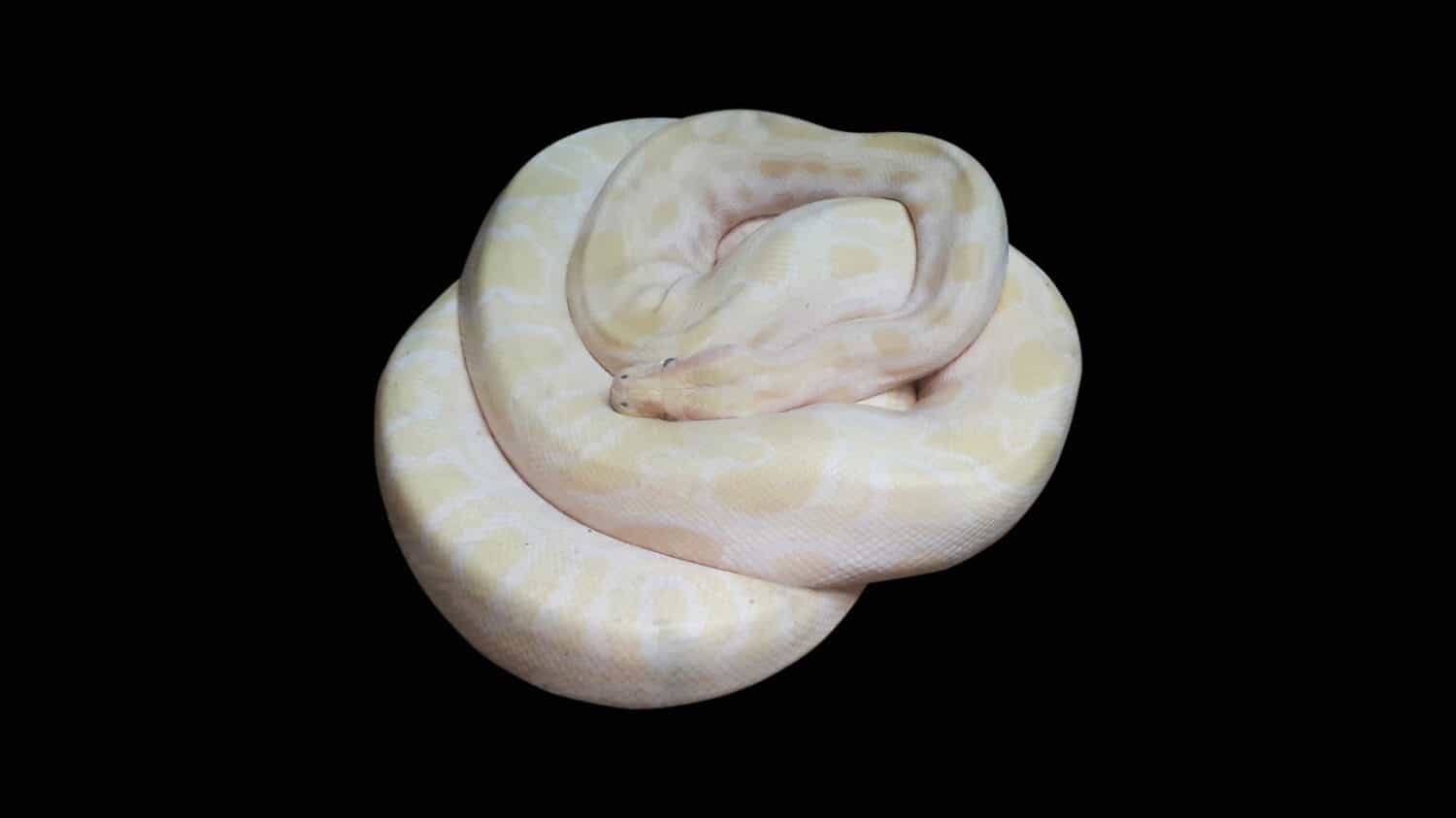
Cow reticulated python hatchlings look similar to this albino retic, but the pattern is almost invisible.
©My_Gook/Shutterstock.com
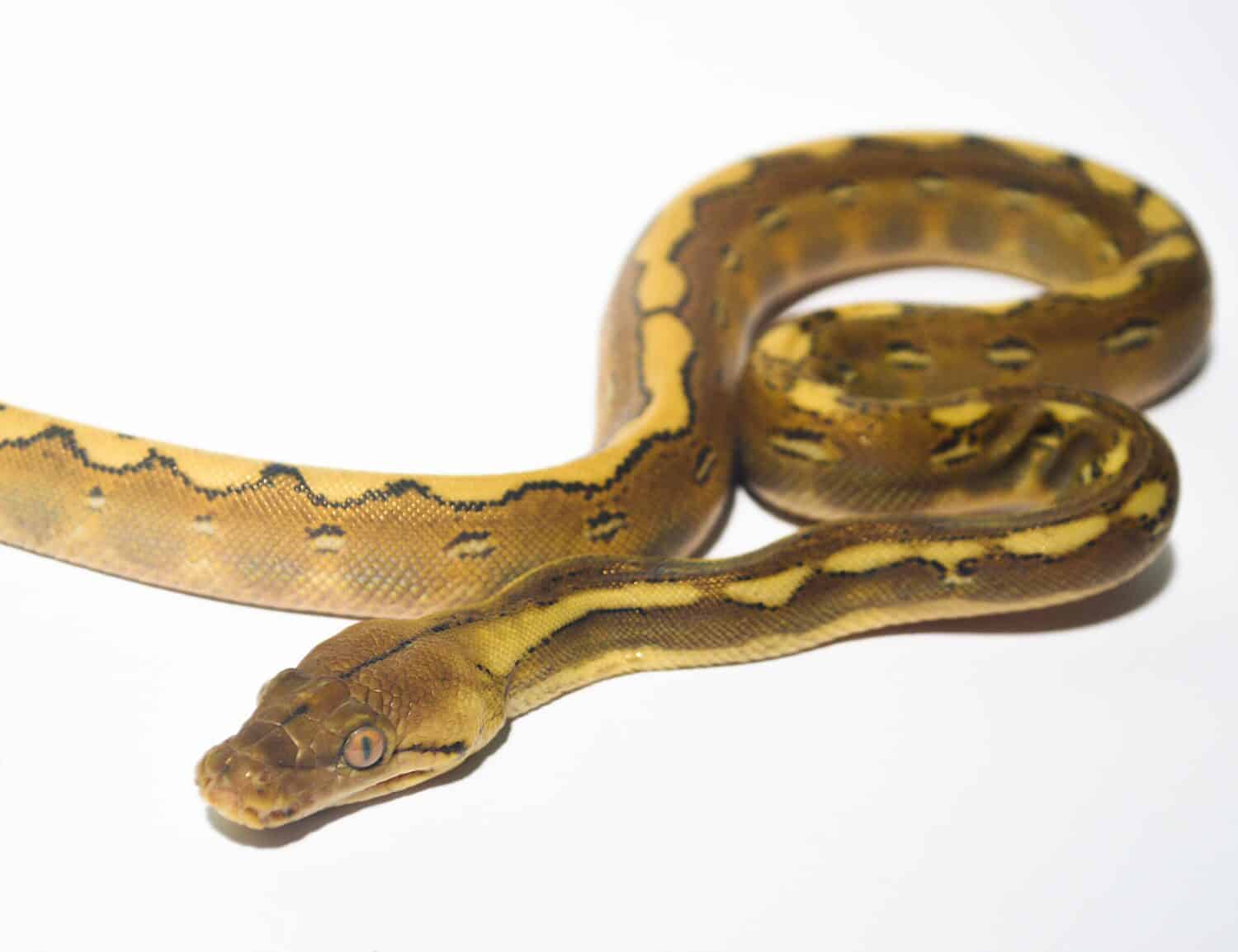
This snake is the result of the platinum and phantom genes — both incomplete dominant traits. Combining animals with different genetic color traits gives pet owners a vast array of choices.
©Hilmy Prasetyo/Shutterstock.com

This lavender albino reticulated python has a beautiful bright pattern — the white areas often turn pink to lavender as these snakes age.
©Nynke van Holten/Shutterstock.com
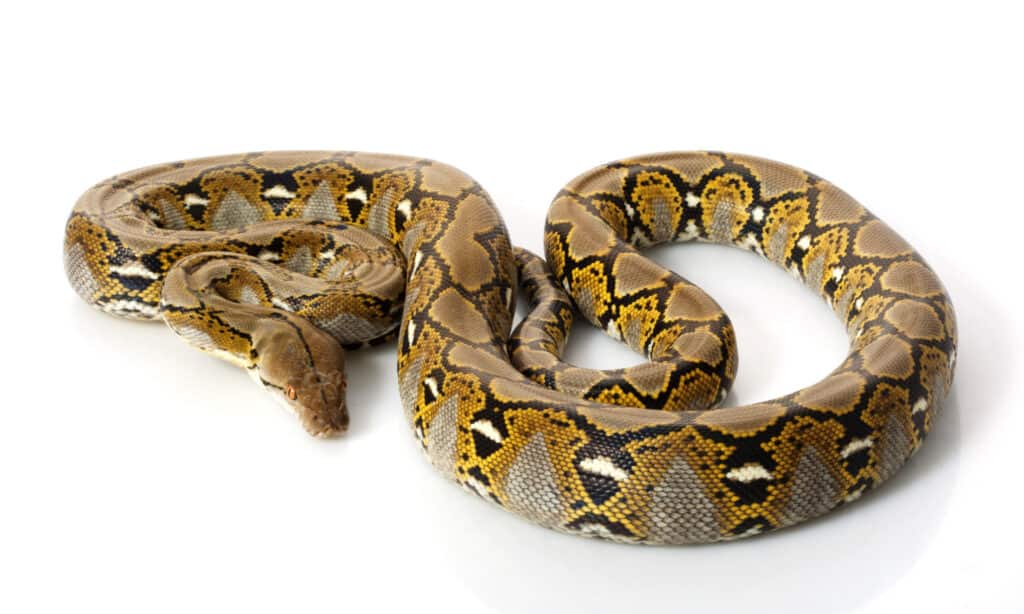
This reticulated python shows the net-like appearance of its markings.
©fivespots/Shutterstock.com
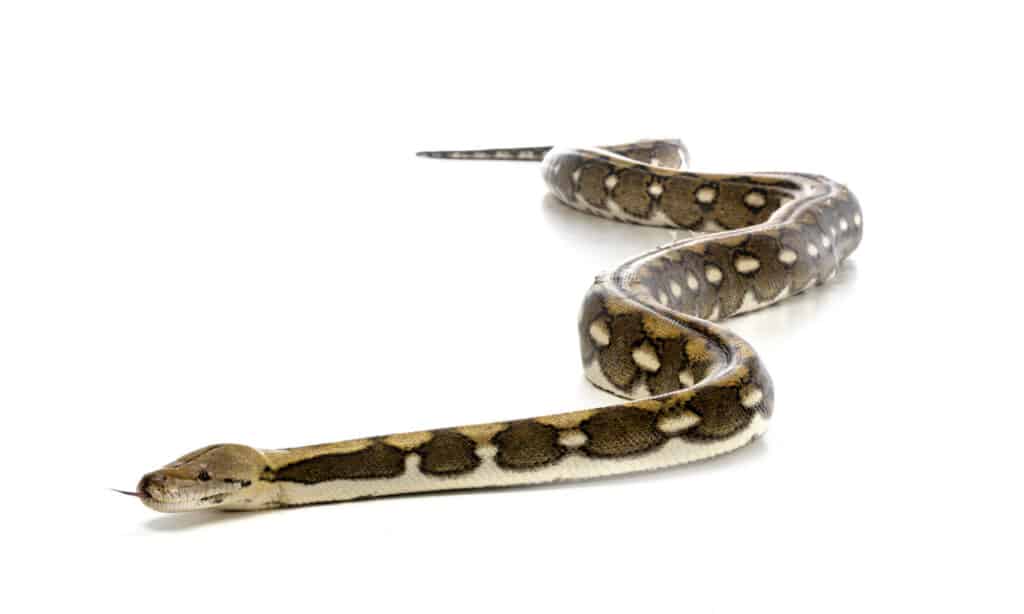
Wild reticulated pythons have few natural enemies as adults, but captive-bred snakes are safe from other predators.
©cynoclub/Shutterstock.com
History and Evolution
Evolutionarily speaking, snakes didn’t start with no legs. The oldest fossils scientists have discovered indicate that they started out looking something like an aquatic lizard — possibly even an amphibian. As other animals do over millennia, snakes specialized, and their bodies began adapting — using their legs less and less until they began to disappear. Some species, like boas and pythons, have vestigial legs or the leftover of what might have been legs in the distant past.
Like many animals, pythons underwent a series of scientific classification changes. Our understanding of the world has changed dramatically, so it’s not surprising that animals’ scientific classification has also changed. Originally, pythons and boas were all in the Boidae family together. Then, as scientists learned more and genetic research showed them even more, they reclassified animals into more appropriate groups.
Boas and pythons are fantastic examples of convergent evolution, where similar species evolve in completely different parts of the world. One big difference between boas and pythons is boas give birth to their babies, and pythons lay eggs. The location of their labial pits differs, too — boas’ heat-sensing pits are between their labial (lip) scales, and pythons’ labial pits are on the scale.
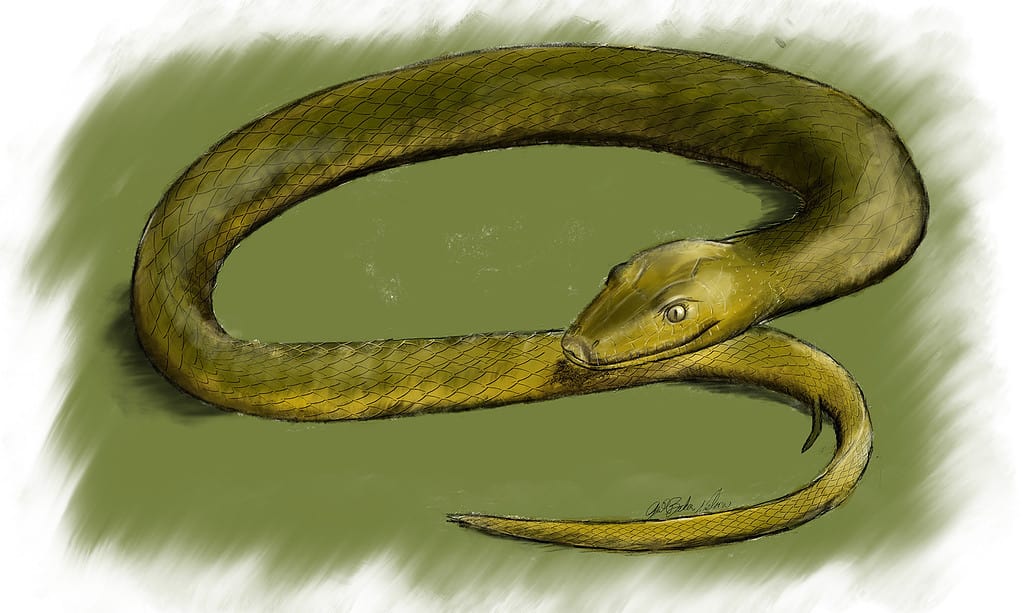
Cow Reticulated Python Behavior
In the wild, reticulated pythons are a bit cranky and not very nice. They’re highly defensive and bite whenever they feel threatened. However, cow reticulated pythons are captive-bred and do not share the same grumpy disposition as those in the wild.
These ambush predators wait for most of their food but actively hunt as necessary. This species is a great example of disruptive camouflage. Wild reticulated pythons’ pattern breaks up the outline of their bodies, making them almost invisible on the jungle floor. Younger snakes may climb more, but as they get bigger and heavier, it becomes more difficult for them to climb!
These snakes are highly intelligent and thrive on appropriate enrichment and interaction. However, they’re also quite large as adults (unless you’re getting a dwarf variety), and it’s wise to have an extra person to help handle them safely when they exceed 10 or 12 feet long.
Properly handled and socialized from a young age, cow reticulated pythons are fantastic pet snakes. They’re docile and gentle, even though they love a good meal. This large snake loves socializing, visiting with its people, and exploring the outside. If you have space, it may even enjoy a swim.
Cow Reticulated Python Habitat
Reticulated pythons in the wild are always close to a water source. These excellent swimmers are large-bodied, and slipping into the water helps them move more quickly from one place to the next. They prefer areas with lots of ground cover, trees, and other areas to hunt for food.
In their enclosure, you can help your cow reticulated python feel safe by having a large enough enclosure for it to explore while having enough space for them to stretch out, roam, and swim. Most experts recommend a minimum enclosure measuring 8’x4’x4′ with the caveat of needing to upgrade as they grow. By the time your cow reticulated python is an adult, you’ll probably need something twice that size.
Cow Reticulated Python Diet
Wild reticulated pythons eat anything they can overpower and strongly prefer mammals and birds. They’re typically ambush predators and find a great hiding spot and wait for prey to wander within striking distance. However, cow reticulated pythons in captivity are limited by what their keepers provide. Luckily, there are several online wholesalers that raise and sell feeder animals, including mice, rats, birds, and even rabbits or pigs. It’s never been easier to feed reptiles than it is now.
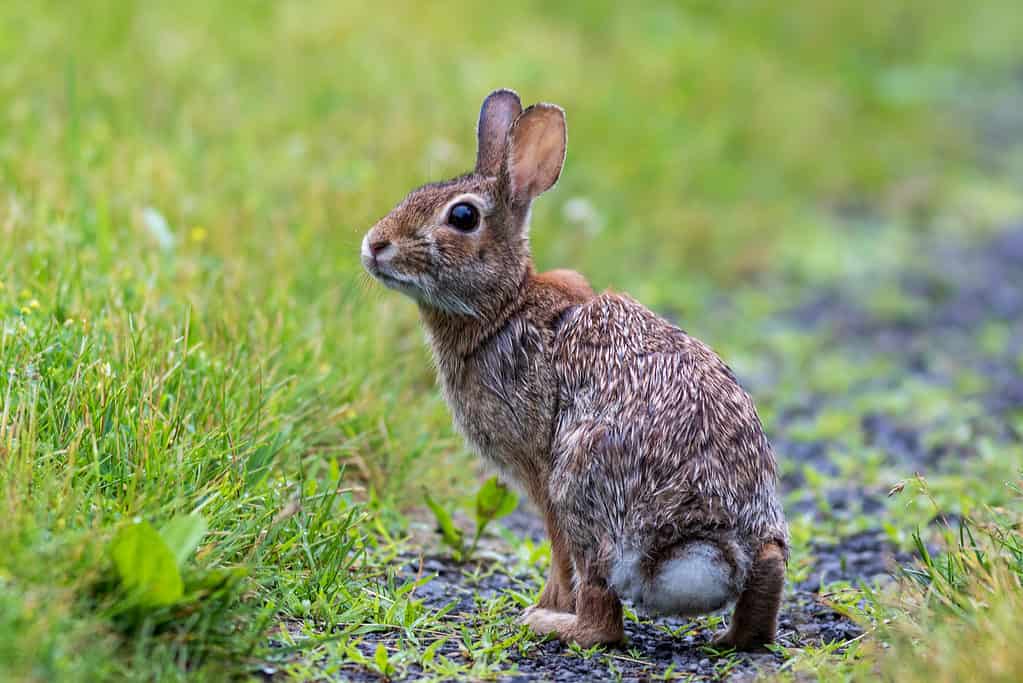
Rabbits are common prey items for adult cow reticulated pythons.
©Rabbitti/Shutterstock.com
Cow Reticulated Python Population and Conservation Status
The IUCN Redlist of Threatened Species classifies wild reticulated pythons as “least concern.” They’re actively hunted by people for the leather and food trade, but populations show no sign of being damaged by it.
However, since cow reticulated pythons aren’t found in the wild, they do not have the same challenges. Breeders and keepers love them for their always-evolving pattern and wonderful temperament.
Cow Reticulated Python Reproduction, Lifespan, and Babies
Like most snakes, reticulated pythons don’t enjoy hanging out with other snakes. They’re only interested in doing that during mating season. These snakes have long lives and can live anywhere from 18 to 30 years in captivity; in the wild, the average is lower.
During mating season, breeders pair animals with desirable traits, hoping for a clutch of 15-80 precious eggs. In the wild, females coil around their eggs until they hatch to help protect and maintain the right temperature for the developing eggs. However, in captivity, breeders often prefer to incubate the eggs separately from the moms because more eggs hatch and the female can return to eating normally sooner.
The eggs take 85-90 days to hatch, depending on the incubation temperature. When they hatch, cow reticulated pythons measure two feet long or more. Although some neonates may have a spot or two, most are solid white with blue eyes.
Like other reticulated pythons, these snakes mature in two to five years and likely live over 20 years in captivity. These large, long-lived snakes will continue to change and develop more spots and color over their lifespan, making beautiful pets.
Similar Animals
View all 235 animals that start with CCow Reticulated Python FAQs (Frequently Asked Questions)
Where do cow reticulated pythons live?
In captivity! This special morph came about as a result of specialized breeding programs.
How much does a cow reticulated python cost?
These snakes can cost anywhere from $500 to several thousand.
What do cow reticulated pythons eat?
Like other reticulated pythons, cow reticulated pythons prefer mammals and birds. As young snakes, they eat mice and rats. Then they graduate to larger prey like rabbits and other mammals.
Are cow reticulated pythons venomous?
No! However, they are large, powerful constrictors that need to be handled with care.
Are cow reticulated pythons aggressive?
Not generally because they’re only bred in captivity. Cow reticulated pythons are handled from the moment they hatch and quickly become accustomed to people.
Thank you for reading! Have some feedback for us? Contact the AZ Animals editorial team.
Sources
- IUCN Redlist, Available here: https://www.iucnredlist.org/species/183151/1730027

















